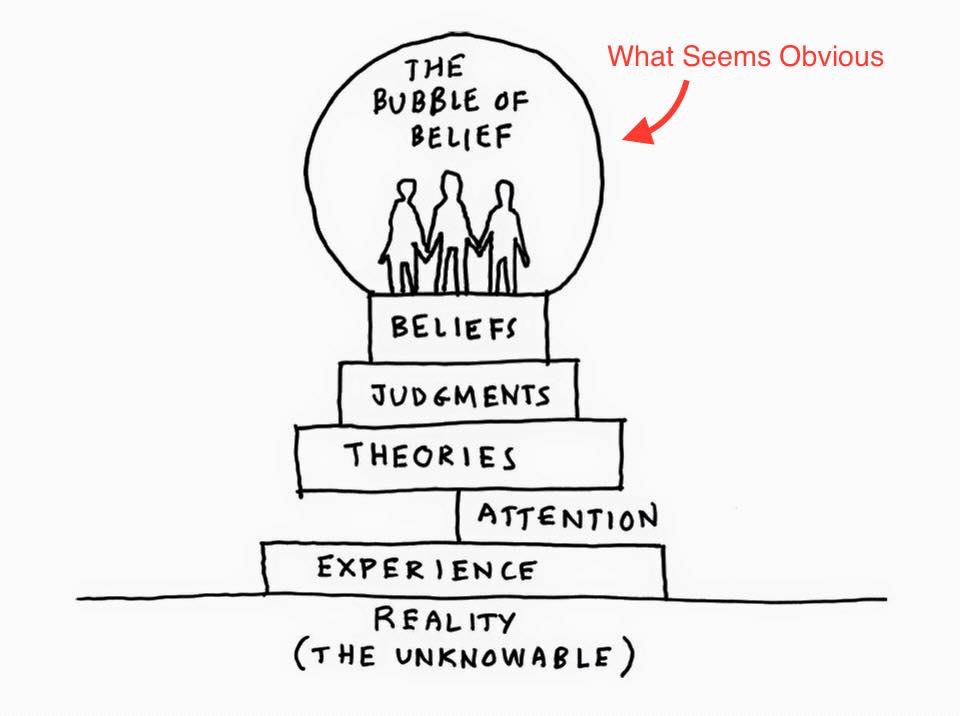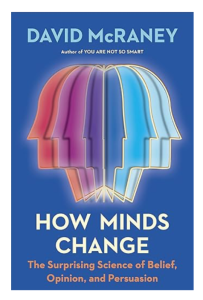It is now undeniable. Global issues like climate change and environment degradation are heading us toward extinction. It is widely recognized that these issues are human caused. If things are to improve there will need to be a widespread change in how we humans understand our place in the world. We need to make a shift from thinking of ourselves as independent persons to seeing ourselves as individuals existing in interconnected webs of interdependency. This entails a fundamental change in our belief systems. And there’s the rub.
Beliefs are not necessarily facts but they are, even when they don’t sync with the facts, the basis of our actions. The beliefs that people have produce behaviours and consequences that are not necessarily warranted by facts. Whether you believe in climate change or not makes a difference. If the facts that we can know about climate change are telling us it’s real but we deny those facts we will take no action to reverse or mitigate its effects.
The thing is whether you believe in climate change or not depends on whether or not you believe the evidence that is presented as facts. So it is important to know how to tell if “facts” are true or not.
People use various methods for this purpose:
1. gut feelings – “intuition”
2. fit with established personal beliefs – “bubble of belief” – support or contradiction
3. evidence – scientific or otherwise
4. trust in authority – accredited or not
5. going along with one’s in-group’s opinion
Getting at the truth may involve making an effort or not. The gut feelings method requires very little effort while the search for evidence may take more effort.

diagram from Liminal Thinking by Dave Grey
The above diagram shows how beliefs form and become a system of related mutually supporting beliefs within a bubble. To each individual it can seem obvious that what they believe is true.
A mindset is a set of beliefs predicated on a belief about an individual’s place in the world (independent vs interdependent view). Mindsets are arrived at through any of the above truth detection systems. Once established they tend to be self-reinforcing due to confirmation bias.
For people to change their beliefs something must penetrate their bubble of belief. The bubble itself is like a semipermeable membrane that filters out any information that contradicts existing beliefs. Information that challenges a belief is rejected while information that supports existing beliefs is allowed to enter the bubble, thus strengthening a person’s existing belief system.
The contents of the bubble are a system of interrelated beliefs that support one another and are all predicated on the overall belief of an individual about his or her independent or interdependent nature.
Since confirmation bias protects the bubble of belief from infection by ideas that are contrary to the enclosed beliefs it is unusual for a person to change a firmly embedded belief, particularly the governing belief about one’s fundamental nature. But, occasionally, it does happen. So if factual information about disparate ideas can’t penetrate the bubble of belief how does this happen?
In a book called “How Minds Change: The Surprising Science  of Belief, Opinion, and Persuasion“ author David McRaney explores just this question. In his quest to find out what factors could be involved when a person adopted a new position on the topic of sexual orientation he followed an organization dedicated to gaining more acceptance for non-binary couples. This group had been making serious efforts for years to learn what worked and what didn’t in terms of changing minds. Because ad campaigns and other faceless approaches had been unsuccessful real people were recruited and sent out to go door to door with the plan to talk to anybody who would listen.
of Belief, Opinion, and Persuasion“ author David McRaney explores just this question. In his quest to find out what factors could be involved when a person adopted a new position on the topic of sexual orientation he followed an organization dedicated to gaining more acceptance for non-binary couples. This group had been making serious efforts for years to learn what worked and what didn’t in terms of changing minds. Because ad campaigns and other faceless approaches had been unsuccessful real people were recruited and sent out to go door to door with the plan to talk to anybody who would listen.
Many strategies were tried and meticulous data was collected along with anecdotal observations from the canvassers. Given the bias strengthening effect of bubbles of belief it is no surprise that empirical facts were found to be ineffective in changing people’s minds. Eventually a different strategy was found to have better success. When canvassers placed more emphasis on establishing a safe atmosphere with the people being interviewed rather than jumping right into the issue of sexual diversity they felt they were being listened to more sympathetically.
Closer analysis of the canvassers’ reports revealed that when this approach was coupled with making an emotional connection to the interviewee there was a greater potential for them to change their stance on the issue to a more accepting one. In particular if a connection could be found to a positive personal experience the person had had with a non-binary person they became even more likely to shift their opinion regarding non-binary people to one of greater acceptance and empathy.
This outcome aligns with research by Johnathan Haight and others showing that humans, for all our pride in being rational creatures, actually make emotionally driven choices more often than not. Most often we use rationality to justify emotional decisions.
So it would seem that if we would like to see more people switching from an independent mindset to an interdependent mindset our best bet could be through person to person conversations where we are aware of the existence of empathy on both sides.
We should try to steer the conversation to an episode in the other person’s life where they experienced their interconnected dependency on at least one other person or living thing.
It is obvious that this process, because it needs to be face to face, one person at a time, is not a quick fix and because of this will not, on its own, be capable of recruiting sufficient numbers of people to tip the tide in favour of the interdependent mindset. But, combined with the many other initiatives working toward this shift in understanding the nature of our existence, it can make a significant contribution to the success of this endeavour.
The rate of success of this approach will depend primarily on two factors: the skill of interviewers and how many there are of them. But, as noted above, the skills can be taught. Also, there is no need to go door to door and interview complete strangers, although that wouldn’t hurt either. If every person reading this article committed to make use of opportunities that naturally arise in their lives, like chats with workmates, social gatherings of any kind, and chance meetings with individuals, the possible number of converts would be substantial. No one knows where the tipping point is in terms of the number of people understanding the importance of interdependence that is needed to make a change in the direction of our civilization. But there is no doubt that every single person’s mindset matters in the attempt to reach that point within whatever time we have left.

